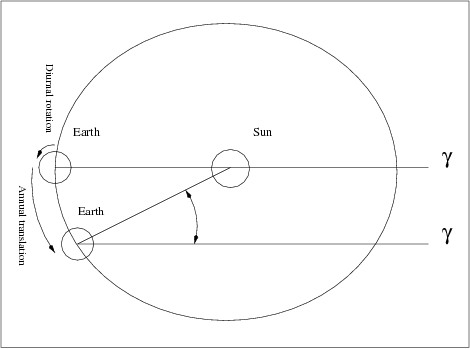If you wish to contribute or participate in the discussions about articles you are invited to contact the Editor
Solar and Sidereal Times relationship: Difference between revisions
Carlos.Lopez (talk | contribs) (Created page with "{{Article Infobox2 |Category=Fundamentals |Title={{PAGENAME}} |Authors= J. Sanz Subirana, JM. Juan Zornoza and M. Hernandez-Pajares, University of Catalunia, Spain. |Level=Medium...") |
Carlos.Lopez (talk | contribs) No edit summary |
||
| Line 8: | Line 8: | ||
}} | }} | ||
There is a slight difference between a sidereal day and a solar (or synodic day) due to the relative movement between the sun and the earth as a consequence of its annual translation. Figure 1 illustrates the concept. | There is a slight difference between a ''sidereal day'' and a ''solar'' (or ''synodic day'') due to the relative movement between the sun and the earth as a consequence of its annual translation. Figure 1 illustrates the concept. | ||
As it is shown in Figure 1, the Aries reference point (<math>\gamma</math>), as seen from the earth, apparently moves counter clockwise during the course of one year (with respect to the sun reference). After one year, the sun and Aries directions coincide again, but the number of laps relative to the sun (solar days) is one less than those relative to Aries (sidereal days). Thence, the solar day is longer than the sidereal day. | As it is shown in Figure 1, the Aries reference point (<math>\gamma</math>), as seen from the earth, apparently moves counter clockwise during the course of one year (with respect to the sun reference). After one year, the sun and Aries directions coincide again, but the number of laps relative to the sun (solar days) is one less than those relative to Aries (sidereal days). Thence, the solar day is longer than the sidereal day. | ||
| Line 15: | Line 15: | ||
The difference between the mean sidereal day and mean solar day | The difference between the ''mean sidereal'' day and ''mean solar day'' can be derived approximately as follows: As in a Solar Tropic year <ref group="footnotes"> ''Tropic year'' is the elapsed time between two successive culminations of sun by the Mean Equinox. It has a duration of 365.2422 mean solar days.</ref>, the mean solar time delayed 1 day respect to the mean sidereal time, thence: | ||
::<math> | ::<math> | ||
| Line 23: | Line 23: | ||
Thence, a sidereal day is shorter than the solar day for about <math>3^m56</math>. | Thence, a ''sidereal day'' is shorter than the solar day for about <math>3^m56</math>. | ||
The conversion between UT1 and Apparent and Mean Sidereal Time is given by equations (2) and (3) (see [[CEP to ITRF]] article) | The conversion between UT1 and ''Apparent'' and ''Mean Sidereal Time'' is given by equations (2) and (3) (see [[CEP to ITRF]] article) | ||
::<math> | ::<math> | ||
Revision as of 12:35, 8 August 2011
| Fundamentals | |
|---|---|
| Title | Solar and Sidereal Times relationship |
| Author(s) | J. Sanz Subirana, JM. Juan Zornoza and M. Hernandez-Pajares, University of Catalunia, Spain. |
| Level | Medium |
| Year of Publication | 2011 |
There is a slight difference between a sidereal day and a solar (or synodic day) due to the relative movement between the sun and the earth as a consequence of its annual translation. Figure 1 illustrates the concept.
As it is shown in Figure 1, the Aries reference point ([math]\displaystyle{ \gamma }[/math]), as seen from the earth, apparently moves counter clockwise during the course of one year (with respect to the sun reference). After one year, the sun and Aries directions coincide again, but the number of laps relative to the sun (solar days) is one less than those relative to Aries (sidereal days). Thence, the solar day is longer than the sidereal day.
The difference between the mean sidereal day and mean solar day can be derived approximately as follows: As in a Solar Tropic year [footnotes 1], the mean solar time delayed 1 day respect to the mean sidereal time, thence:
- [math]\displaystyle{ \frac{24^h}{365.2422}\simeq 3^m56^s \qquad \mbox{(1)} }[/math]
Thence, a sidereal day is shorter than the solar day for about [math]\displaystyle{ 3^m56 }[/math].
The conversion between UT1 and Apparent and Mean Sidereal Time is given by equations (2) and (3) (see CEP to ITRF article)
- [math]\displaystyle{ \Theta_{_G}=\theta_{_G} +\alpha _E \qquad \mbox{(2)} }[/math]
- [math]\displaystyle{ \theta_{G_0}=6^h41^m 50^s_{\cdot}54841+8640184_{\cdot}^s812866\,T_u+0_{\cdot}^s093104\,T_u^2-6^s_{\cdot}2 \, 10^{-6}\, T_u^3 \qquad \mbox{(3)} }[/math]
Notes
- ^ Tropic year is the elapsed time between two successive culminations of sun by the Mean Equinox. It has a duration of 365.2422 mean solar days.


